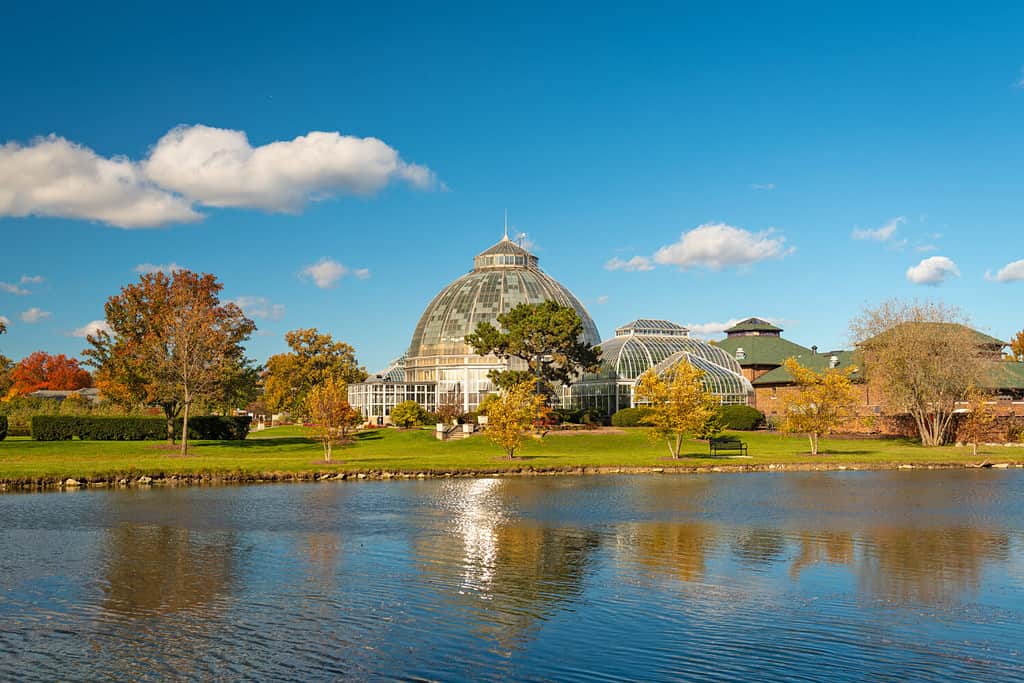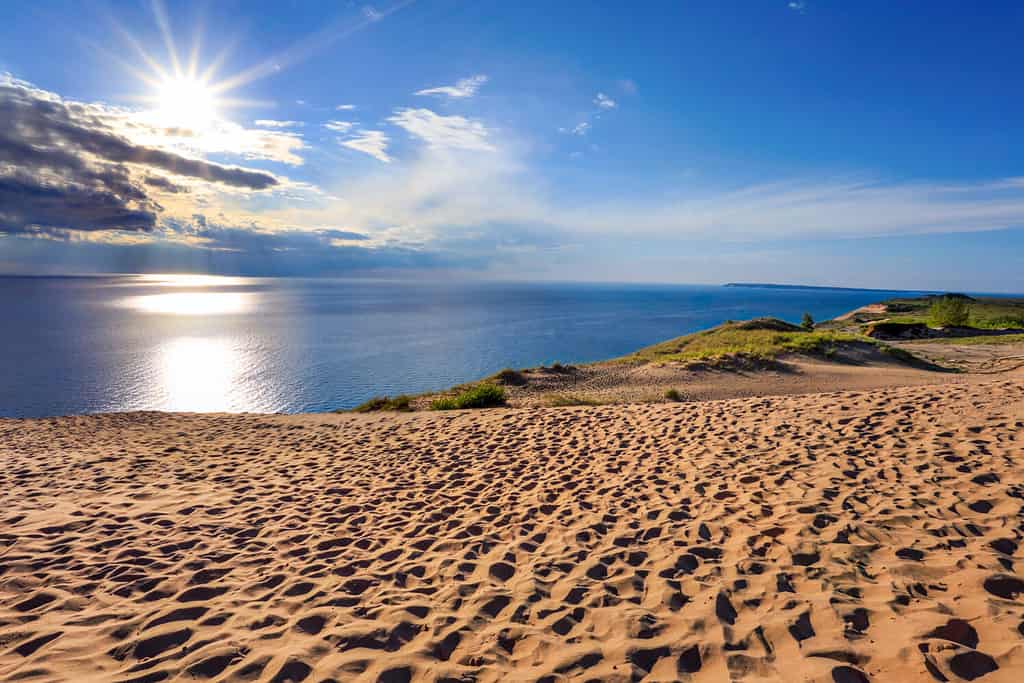Did you ever stop to think about how your state got its name? The origin of each U.S. state name can tell you a lot about its history and what the state is known for. In this article, we’ll dive into the meaning of Michigan and where its name came from.
Michigan is an upper Midwestern state in the Great Lakes region of the country. In fact, it’s the only state that touches four of the five Great Lakes: Lake Superior, Lake Huron, Lake Erie, and Lake Michigan. Nicknamed “The Great Lakes State,” with much of the regions labeled “America’s Third Coast,” the state features a diverse landscape and a calm climate.
Known for its automobile industry, Great Lakes shorelines, and agricultural productivity, Michigan is the only state that’s divided into two peninsulas: one upper and one lower. Michigan is a hot spot for travelers and nature lovers alike because of its natural beauty, outdoor activities, and vast wildlife. Here’s how Michigan got its name, where it derived from, and a list of its official state animals and other wildlife.
How Did Michigan Get Its Name?
The name Michigan derives from the Indian word “Michigama,” which translates to “big lake” or “great water.” In other words, the state of Michigan got its name from Lake Michigan — the second largest of the five Great Lakes. As noted earlier, the state borders four of the five Great Lakes.
Michigan became a state on January 26, 1837, making it the 26th U.S. state. Before that, it was part of the original territory of the United States, “Territory northwest of the River Ohio” in 1787. In 1805, the Michigan Territory was established and included the Lower Peninsula, the eastern part of the Upper Peninsula, part of northern Indiana, and part of northwestern Ohio. Later in 1818, Illinois became a state, and the leftover regions of Illinois Territory became part of Michigan Territory. Over the next several years, Michigan Territory was both reduced and enlarged, gaining and losing certain regions as more states became established. Eventually, it became its own state in 1837.

Michigan is a beautiful place to visit year-round, but especially during autumn.
©Sean Pavone/Shutterstock.com
How Did Michigan Get Its Nicknames?
Michigan has many state nicknames, with the most popular being “The Great Lakes State.” This is because it’s the only state touching four of the Great Lakes — more than any other state. Additionally, Michigan has over 10,000 lakes, which also gives it the less specific names of “Lake State” and “Lady of the Lake.”
Another well-known state nickname for Michigan is the “Wolverine State” — but probably not for the reason you’re thinking. There aren’t any wild wolverines wandering the land (they’re more present in states like Oregon, Washington, Montana, Colorado, and Wyoming), but many theories suggest this name came from the trading of wolverine fur/pelts centuries ago. Others believe it has to do with the lumberjacks who settled in the area in the 1800s, as they possessed a “wolverine-like” nature and tenacity to them. Some even theorize there was a time when wolverines would roam the Michigan peninsula.
Michigan is America’s “Water Winter Wonderland,” a nickname on Michigan license plates from 1955 to 1964. Since the state’s greatest attractions are its bodies of water, it makes sense why this nickname stuck.
“The Mitten State” is yet another common moniker for Michigan, as the state’s shape resembles a mitten (specifically the Lower Peninsula). This is especially fitting considering the state’s cold winter months.

Lake Michigan is a popular attraction in the state of Michigan.
©Doug Lemke/Shutterstock.com
Additional Michigan Nicknames
Here are a few other (lesser-known) nicknames for the state of Michigan:
- “America’s Left Hand:” The mitten-shaped state clearly resembles a left hand, which is how the state got this name. Additionally, Michigan’s lower and upper peninsulas look like they’re high-fiving.
- The “Automotive State:” Michigan was once the center of the U.S. automotive industry and is home to the three major automobile companies.
- The “Orange Barrel State:” Michigan’s state flower is the orange barrel, making this nickname self-explanatory.
- The “Wheat State:” Michigan is known for its wheat production, giving it this fitting moniker. In fact, the state has its own wheat program that benefits nearly 8,000 wheat farmers in Michigan.
Michigan State Motto
Michigan’s state motto is “Si Quaeris Peninsulam Amoenam Circumspice,” which is Latin for “If you seek a pleasant peninsula, look about you.” In other words, look no further than Michigan for gorgeous scenery. Michigan has both an Upper Peninsula in the north and a Lower Peninsula in the south.
Wildlife in Michigan
As a midwestern state bordering Indiana, Ohio, Wisconsin, Great Lakes, and Canada, Michigan offers visitors, residents, and wildlife stunning natural landscapes. Rich with lakes, ponds, marshes, and forests, the state is home to many different species. Michigan’s five state animals include:
- State Bird: American Robin (Turdus migratorius)
- State Game Mammal: White-Tailed Deer (Odocoileus virginianus)
- State Fossil: Mastodon (Mammut americanum)
- State Fish: Brook Trout (Salvelinus fontinalis)
- State Reptile: Painted Turtle (Chysemys picta)

Due to the many bodies of water in Michigan, you can find various species of fish in the state.
©Paul Winterman/Shutterstock.com
Some additional wildlife you can find in Michigan includes moose, coyotes, raccoons, black bears, gray wolves, bobcats, squirrels, groundhogs, bats, North American river otters, muskrats, elk, opossums, turkey, red foxes, sandhill cranes, beavers, rabbits, and more.
Michigan is also known for its incredible fishing opportunities — especially in the Great Lakes. Some of the unique fish you can find in Michigan are Atlantic salmon, largemouth bass, smallmouth bass, brown trout, catfish, bullheads, chinook salmon, coho salmon, common carp and suckers, crappies, Menominee, muskellunge, northern pike, pink salmon, rainbow trout, walleye, yellow perch, and many more. Fishermen can surf fish from the shorelines or book a charter on one of the Great Lakes for deeper fishing.
The three largest animals you’ll find in Michigan include the American bison (up to six feet tall and 2,000 pounds), white-tailed deer (up to four and a half feet tall and 250 pounds), and moose (up to six feet tall and 1,800 pounds).
Michigan also features many dangerous animals. The most threatening include Eastern Massasauga rattlesnakes, black bears, wolves, and black widow spiders, which carry venom with dangerous neurotoxins.
As for endangered animals, Michigan has a ton, including (but not limited to):
- Boreal woodland caribou
- Indiana bat
- Kirtland’s warbler
- Spotted turtle
- Copperbelly water snake
- Piping plover
- Hine’s emerald dragonfly
- Hungerford’s Crawling Water Beetle
- Karner blue butterfly
- Poweshiek skipperling
- Mitchell’s satyr
Spotting Michigan Wildlife
If you’re planning a trip to Michigan and would like an opportunity to spot wildlife, you’re in luck. The state is known for its birding, elk viewing, and sandhill crane spotting. You can go birding in Michigan all year round, as each season offers different species to view. Boasting over 450 bird species, the state has many birding trails, state parks, recreation areas, state wildlife and game areas, national wildlife refuges, and coastlines to view these gorgeous creatures.
For elk viewing (a popular visitor attraction), you’ll want to visit Michigan in autumn. Specifically, visit during the months of September and October. You can find elk in Michigan’s Pigeon River Country State Forest, which features around one thousand elk.
If sandhill cranes are what you’re after, visit the state during autumn for the best chance to see these birds. Each fall, thousands of sandhill cranes migrate to the southern Lower Peninsula of Michigan. You can find them in the marshlands of Jackson and Washtenaw counties during the months of October and early November. These birds grow up to five feet tall with six-foot wingspans and have bright red heads, making them easy to spot.
The photo featured at the top of this post is © Thomas Barrat/Shutterstock.com
Thank you for reading! Have some feedback for us? Contact the AZ Animals editorial team.






